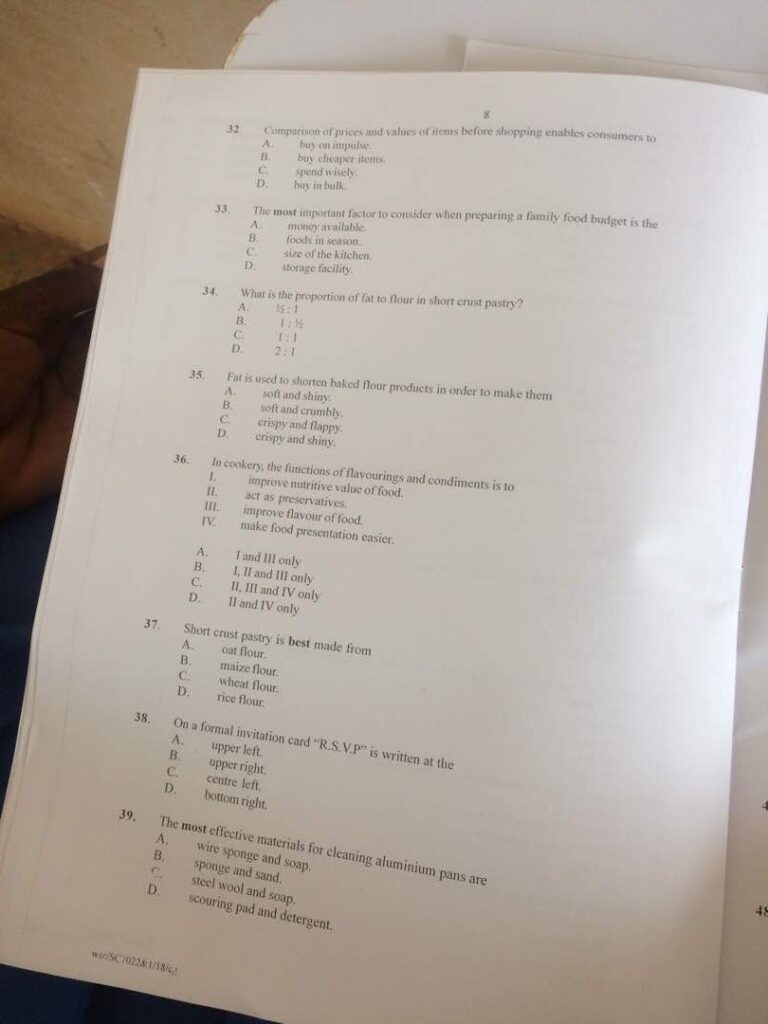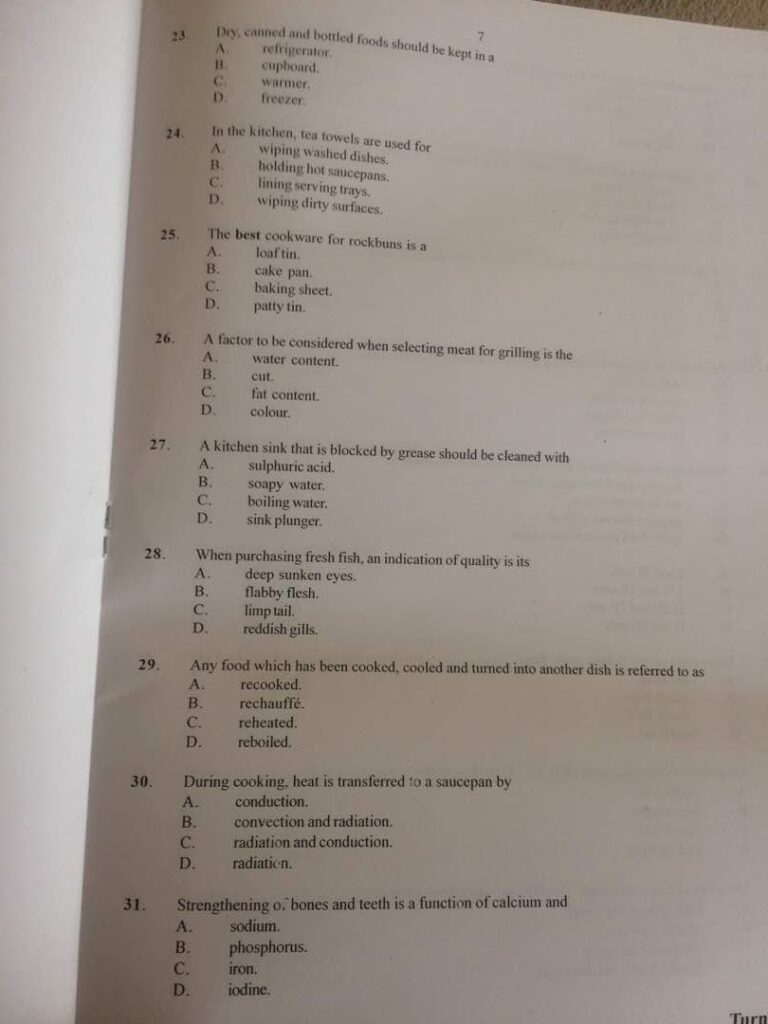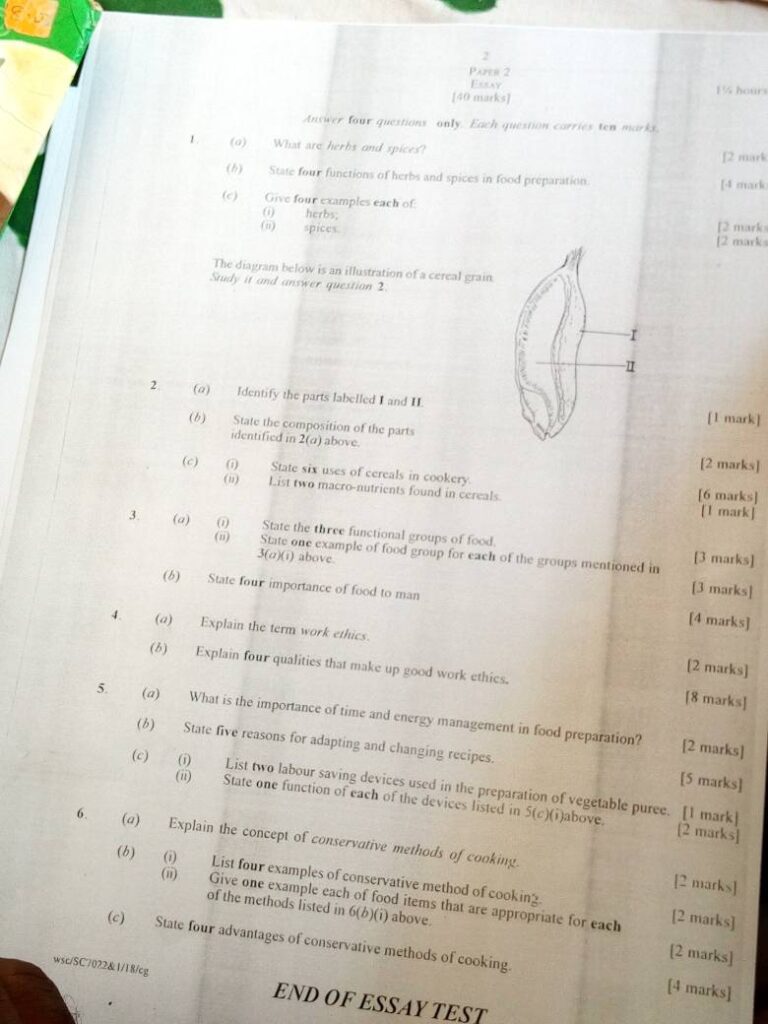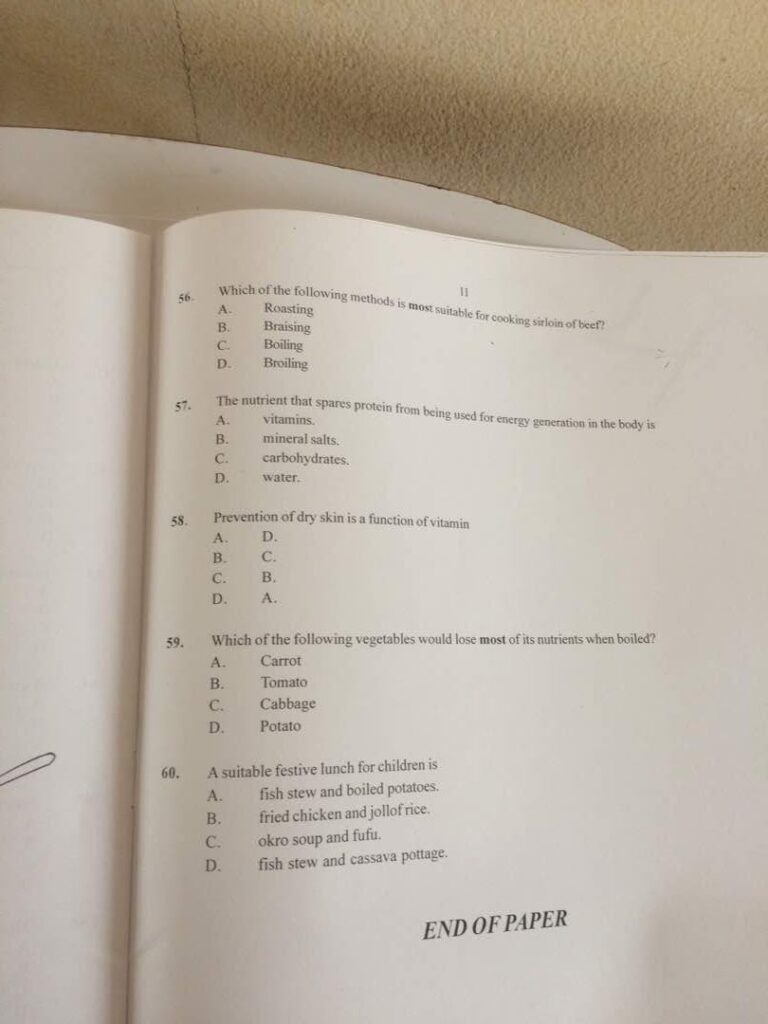Here is collection of WAEC Food and Nutrition Past Question and Answers Pdf to assist you with your studies for the West African Senior School Certificate Examination (WASSCE) for both School and GCE candidates.
If you are in your last stage of Secondary School Education (May/June) or not in the School system (GCE), the importance of using old exam papers in preparing for your West African Senior School Certificate Examination (WASSCE), cannot be over emphasized. By using past exam papers as part of your preparation, you can find out what you already know. By the same token you also find out what you do not know well enough or don’t know at all.
Food and Nutrition Waec 2023


Food and Nutrition Waec 2022


What is more, the WAEC Food and Nutrition Past Question and Answers Pdf can also be used as an organizational tool to manage your time better, as you can plan according to each section of the paper.
As a matter of fact, revision is more better than memorizing facts and going over notes. You can practice for your WAEC Food and Nutrition Past Question and Answers Pdf by answering real questions from past papers. This will give you a better chance of passing.
Test Interpretation in Food and Nutrition WAEC
Click on the year you want to start your revision.
- WAEC Food and Nutrition Past Question and Answers Pdf
- WAEC Food and Nutrition Past Question and Answers Pdf
- WAEC Food and Nutrition Past Question and Answers Pdf
What is Balance diet?
A balanced diet is a way of eating that includes a variety of foods from all the food groups in appropriate proportions to support overall health and well-being. It typically consists of:
- Fruits and Vegetables: These provide essential vitamins, minerals, and fiber. Aim to include a variety of colorful fruits and vegetables in your diet.
- Protein: Sources of protein include meat, poultry, fish, eggs, dairy products, legumes (such as beans and lentils), nuts, and seeds. Protein is important for building and repairing tissues, as well as for various bodily functions.
- Grains: Whole grains like brown rice, whole wheat bread, oats, quinoa, and barley are good sources of carbohydrates, fiber, and essential nutrients.
- Dairy or Dairy Alternatives: Milk, yogurt, and cheese provide calcium, vitamin D, and other nutrients important for bone health. For those who are lactose intolerant or prefer plant-based options, fortified plant-based milk alternatives like almond milk or soy milk can be consumed.
- Healthy Fats: Sources of healthy fats include avocados, nuts, seeds, olive oil, and fatty fish like salmon. These fats are important for brain health, hormone production, and absorption of fat-soluble vitamins.
- Water: Staying hydrated is essential for overall health. Water is the best choice for hydration, but other beverages like herbal teas and low-sugar fruit juices can also contribute to fluid intake.
A balanced diet provides the nutrients and energy needed for optimal health, growth, and development, while also reducing the risk of chronic diseases such as heart disease, diabetes, and certain cancers. It’s important to listen to your body’s hunger and fullness cues, eat mindfully, and enjoy a variety of foods in moderation.
Nutritional Deficiency Diseases
Nutritional deficiency diseases happen when your body doesn’t get enough important nutrients from food. Here are some common ones:
- Iron Deficiency Anemia: This happens when you don’t get enough iron, which is important for making red blood cells. Symptoms include feeling tired, weak, and having pale skin.
- Vitamin D Deficiency: Vitamin D is needed for strong bones and a healthy immune system. Not enough of it can lead to weak bones and muscles, and a higher chance of getting sick.
- Vitamin B12 Deficiency: This vitamin is important for your nerves and making red blood cells. Not having enough can cause tiredness, numbness in your hands and feet, and problems with your nerves.
- Iodine Deficiency Disorders: Iodine is important for making thyroid hormones. If you don’t get enough, you might get a goiter (a swollen thyroid gland), have thyroid problems, or not grow properly.
- Vitamin A Deficiency: This vitamin is important for your eyesight, skin, and immune system. If you don’t get enough, you might have trouble seeing in the dark, get sick more often, or have problems with your skin.
- Calcium Deficiency: Calcium is important for strong bones and teeth. Not enough calcium can lead to weak bones, muscle cramps, and problems with your nails.
- Zinc Deficiency: Zinc helps your immune system, wound healing, and growth. If you don’t get enough, you might get sick more often, have trouble healing from wounds, and lose your hair.
- Folate Deficiency: Folate is important for making DNA and new cells. If you don’t get enough, you might feel tired, have trouble making red blood cells, and if you’re pregnant, your baby might have birth defects.
- Vitamin C Deficiency (Scurvy): Vitamin C is important for your skin, bones, and immune system. Not enough of it can lead to tiredness, bleeding gums, and problems with your skin.
To avoid these diseases, it’s important to eat a balanced diet with plenty of fruits, vegetables, whole grains, lean proteins, and dairy products. If you think you might have a nutritional deficiency, talk to your doctor. They can help you figure out what you need to do to stay healthy.
Test Interpretation in Food and Nutrition WAEC
Interpreting test questions in food and nutrition for WAEC involves understanding the key concepts and applying them to specific scenarios or problems presented in the question. Here are some general steps to interpret test questions effectively:
- Read Carefully: Begin by reading the question carefully, paying attention to any keywords or phrases that indicate what is being asked. Look for terms like “explain,” “describe,” “compare,” or “calculate,” which provide clues about the type of response required.
- Identify Key Concepts: Identify the main concepts or topics covered in the question. This might include principles of nutrition, food composition, meal planning, food safety, or dietary guidelines.
- Analyze the Scenario: Analyze any scenario or problem presented in the question. Consider factors such as the types of foods involved, dietary requirements, nutritional needs of specific groups (such as children, pregnant women, or athletes), or food-related health issues.
- Apply Knowledge: Use your understanding of food and nutrition principles to address the question. Apply relevant information from your studies, textbooks, and class notes to provide accurate and comprehensive responses.
- Use Examples: Whenever possible, use examples to illustrate your points or support your answers. Examples can help clarify your understanding and demonstrate how theoretical concepts apply in real-life situations.
- Show Calculations: If the question involves calculations, show your work clearly and provide explanations for each step. Double-check your calculations to ensure accuracy.
- Be Concise: Provide clear and concise answers that directly address the question. Avoid unnecessary information or lengthy explanations unless specifically requested.
- Check for Understanding: After completing your response, review your answer to ensure that you have addressed all parts of the question accurately. Make any necessary revisions or clarifications before moving on to the next question.
By following these steps, you can effectively interpret test questions in food and nutrition for WAEC and provide well-informed and accurate responses. Practice interpreting various types of questions to improve your proficiency and confidence in the subject area.
Do you have any other past question(s) other than the ones listed here? If yes, don’t hesitate to share them with others by sending it to admin@waecafrica.com.
You have to keep trying more than one exam to increase your success in the forthcoming WAEC Exam.
Spread the Word: If you found this post useful, help others discover it too! Just click and share using the buttons below!
